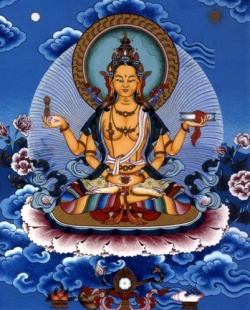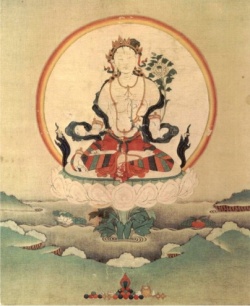Prajnaparamita
Prajñāpāramitā (Sanskrit: प्रज्ञापारमिता) in Buddhism, means "the Perfection of (Transcendent) Wisdom." The word Prajñāpāramitā combines the Sanskrit words prajñā ("wisdom") with pāramitā ("perfection"). Prajñāpāramitā is a central concept in Mahāyāna Buddhism and its practice and understanding are taken to be indispensable elements of the Bodhisattva Path. The practice of Prajñāpāramitā is elucidated and described in the genre of the Prajñāpāramitā Sūtras, which vary widely in length and exhaustiveness. The Prajñāpāramitā Sutras suggest that all things are illusory. The earliest Mahayana Sutras were of the Prajñāpāramitā type.
Earliest texts
Aṣṭasāhasrikā Prajñāpāramitā
Western scholars have traditionally considered the earliest sūtra in the Prajñāpāramitā class to be the Aṣṭasāhasrikā Prajñāpāramitā Sūtra or "Perfection of Wisdom in 8,000 Lines", which was probably put in writing in the 1st century BCE. This chronology is based on the views of Edward Conze, who largely considered dates of translation into other languages. The first translation of the Aṣṭasāhasrikā Prajñāpāramitā into Chinese occurred in the 2nd century CE. This text also has a corresponding version in verse format, called the Ratnaguṇasaṃcaya Gāthā, which some believe to be slightly older because it is not written in standard literary Sanskrit. However, these findings rely on late-dating Indian texts, in which verses and mantras are often kept in more archaic forms.
Additionally, a number of scholars have proposed that the Mahāyāna Prajñāpāramitā teachings were first developed by the Caitika subsect of the Mahāsāṃghikas. They believe that the Aṣṭasāhasrikā Prajñāpāramitā Sūtra originated amongst the southern Mahāsaṃghika schools of the Āndhra region, along the Kṛṣṇa River. These Mahāsaṃghikas had two famous monasteries near the Amarāvati and the Dhānyakataka, which gave their names to the schools of the Pūrvaśailas and the Aparaśailas. Each of these schools had a copy of the Aṣṭasāhasrikā Prajñāpāramitā Sūtra in prakrit. Guang Xing also assesses the view of the Buddha given in the Aṣṭasāhasrikā Prajñāpāramitā Sūtra as being that of the Mahāsaṃghikas. Edward Conze estimates that this sūtra originated around 100 BCE.
Vajracchedikā Prajñāpāramitā
In contrast to western scholarship, Japanese scholars have traditionally considered the Diamond Sūtra (Vajracchedikā Prajñāpāramitā Sūtra) to be from a very early date in the development of Prajñāpāramitā literature.[ The usual reason for this relative chronology which places the Vajracchedikā earlier is not its date of translation, but rather a comparison of the contents and themes. Some western scholars also believe that the Aṣṭasāhasrikā Prajñāpāramitā Sūtra was adapted from the earlier Vajracchedikā Prajñāpāramitā Sūtra.
Examining the language and phrases used in both the Aṣṭasāhasrikā and the Vajracchedikā, Gregory Schopen also sees the Vajracchedikā as being earlier than the Aṣṭasāhasrikā. This view is taken in part by examining parallels between the two works, in which the Aṣṭasāhasrikā seems to represent the later or more developed position. According to Schopen, these works also show a shift in emphasis from an oral tradition (Vajracchedikā) to a written tradition (Aṣṭasāhasrikā).
Overview of the Prajñāpāramitā sūtras
An Indian commentary on the Mahāyānasaṃgraha, entitled Vivṛtaguhyārthapiṇḍavyākhyā, gives a classification of teachings according to the capabilities of the audience:
[A]ccording to disciples' grades, the Dharma is [classified as] inferior and superior. For example, the inferior was taught to the merchants Trapuṣa and Ballika because they were ordinary men; the middle was taught to the group of five because they were at the stage of saints; the eightfold Prajñāpāramitās were taught to bodhisattvas, and [the Prajñāpāramitās] are superior in eliminating conceptually imagined forms. The eightfold [Prajñāpāramitās] are the teachings of the Prajñāpāramitā as follows: the Triśatikā, Pañcaśatikā, Saptaśatikā, Sārdhadvisāhasrikā, Aṣṭasāhasrikā, Aṣṭadaśasāhasrikā, Pañcaviṃśatisāhasrikā, and Śatasāhasrikā.
The titles of these eight Prajñāpāramitā texts are given according to their length. The texts may have other Sanskrit titles as well, or different variations which may be more descriptive. The lengths specified by the titles are given below.
Triśatikā Prajñāpāramitā Sūtra: 300 lines, the Diamond Sūtra, or Vajracchedikā Prajñāpāramitā Sūtra
Pañcaśatikā Prajñāpāramitā Sūtra: 500 lines
Saptaśatikā Prajñāpāramitā Sūtra: 700 lines, the bodhisattva Mañjuśrī's exposition of Prajñāpāramitā
Sārdhadvisāhasrikā Prajñāpāramitā Sūtra: 2500 lines, from the questions of Suvikrāntavikrāmin Bodhisattva
Aṣṭasāhasrikā Prajñāpāramitā Sūtra: 8000 lines
Aṣṭadaśasāhasrikā Prajñāpāramitā Sūtra: 18,000 lines
Pañcaviṃśatisāhasrikā Prajñāpāramitā Sūtra: 25,000 lines
Śatasāhasrikā Prajñāpāramitā Sūtra: 100,000 lines, also called the Mahāprajñāpāramitā Sūtra
According to Joseph Walser, there is evidence that the Pañcaviṃśatisāhasrikā Prajñāpāramitā Sūtra (25,000 lines) and the Śatasāhasrikā Prajñāpāramitā Sūtra (100,000 lines) have a connection with the Dharmaguptaka sect, while the Aṣṭasāhasrikā Prajñāpāramitā Sūtra (8000 lines) does not.
In addition to these, there are also other Prajñāpāramitā sūtras such as the Heart Sūtra (Prajñāpāramitā Hṛdaya), which exists in both 14-line and 25-line versions. Regarding the shorter texts, Edward Conze writes, "Two of these, the Diamond Sūtra and the Heart Sūtra are in a class by themselves and deservedly renowned throughout the world of Northern Buddhism. Both have been translated into many languages and have often been commented upon."
Tāntric versions of the Prajñāpāramitā literature were produced from the year 500 CE on. Additionally, Prajñāpāramitā terma teachings are held by some Tibetan Buddhists to have been conferred upon Nāgārjuna by Nāgarāja, King of Nāgas, who had been guarding them at the bottom of the sea.
Xuanzang and the Mahāprajñāpāramitā
Xuanzang returned to China from India with three copies of the Mahāprajñāpāramitā Sūtra which he had secured from his extensive travels.[18] Xuanzang, with a team of disciple translators, commenced translating the voluminous work in 660 CE using the three versions to ensure the integrity of the source documentation.[18] Xuanzang was being encouraged by a number of the disciple translators to render an abridged version. After a suite of dreams quickened his decision, Xuanzang determined to render an unabridged, complete volume, faithful to the original of 600 fascicles.
Prajnaparamita in visual art
The Prajnaparamita is often personified as a bodhisattvadevi (female bodhisattva). Artifacts from Nalanda depict the Prajnaparamita personified as a goddess. The depiction of Prajnaparamita statue as a goddess is also can be found in ancient Java and Cambodian art.
Prajnaparamita in Ancient Indonesia
Mahayana buddhism took root in ancient Java Sailendra court in the 8th century CE. The Mahayana reverence of female buddhist deity started with the cult of Tara enshrined in the 8th century Kalasan temple in Central Java. Some of Prajnaparamita's important functions and attributes can be traced to those of the goddess Tara. Tara and Prajnaparamita are both referred to as mothers of all Buddhas, since Buddhas are born from wisdom. The Sailendra dynasty was also the ruling family of Srivijaya buddhist empire in Sumatra. During the reign of the third Pala king Devapala (815-854) in India, Srivijaya Maharaja Balaputra of Sailendras also constructed one of Nalanda’s main monasteries in India itself. Thereafter manuscript editions of the Ashtasahasrika Prajnaparamita Sutra circulating in Sumatra and Java instigated the cult of the 'Goddess of Transcendent Wisdom'.[20] In 13th century, the tantric buddhism gained royal patronage of king Kertanegara of Singhasari, and thereafter some of Prajnaparamita statues were produced in the region, such as the Prajnaparamita of Singhasari in East Java and Prajnaparamita of Jambi, Sumatra. Both of East Java and Jambi Prajnaparamitas bear resemblance in style as they were produced in same period, however unfortunately Prajnaparamita of Jambi is headless and was discovered in poor condition.
The statue of Prajnaparamita of East Java is probably the most famous depiction of the goddes of transcendental wisdom. It was discovered in almost perfect condition in the Cungkup Putri ruins near Singhasari temple, Malang, East Java. Local tradition links the statue to Queen Ken Dedes the first queen of Singhasari, probably as a deified portrayal of the queen. Another opinion links the statue with Queen Gayatri, the consort of Kertarajasa the first king of Majapahit. The statue was discovered in 1818 or 1819 by D. Monnereau, a Dutch East Indies official. In 1820 Monnereau gave the statue to C.G.C. Reinwardt, who later brought the statue to the Netherlands, where it became a prized possession of the Rijksmuseum voor Volkenkunde in Leiden. In January 1978, the Rijksmuseum voor Volkenkunde returned the statue to Indonesia, where it was placed in National Museum of Indonesia. Today the beautiful and serene statue is displayed on 2nd floor Gedung Arca, Indonesian National Museum, Jakarta.

